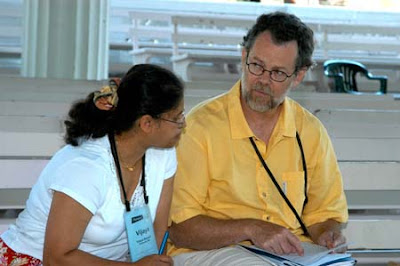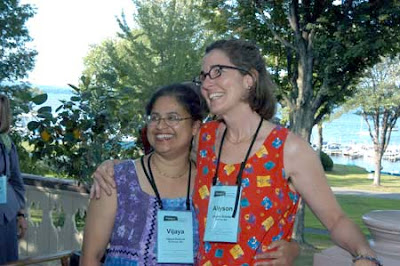 Update: The Highlights Foundation holds all its workshops in Honesdale, PA now. I had the wonderful opportunity to attend Sharing our Hope workshop with Kristi Holl and Paula Morrow three years ago but what I learned at Chautauqua still holds true.
Update: The Highlights Foundation holds all its workshops in Honesdale, PA now. I had the wonderful opportunity to attend Sharing our Hope workshop with Kristi Holl and Paula Morrow three years ago but what I learned at Chautauqua still holds true.
From the web archives: Chatauqua Musings
Chautauqua: a single word. A place. But so much more than that. For me, the Highlights Foundation’s 2006 Writers Workshops at Chautauqua was a place to learn about children’s writing from some of the best authors and editors in the field. What is unique about Chautauqua is the family atmosphere, the caring and the passion. Faculty and students enjoy meals together and are available to talk shop, family, or hobbies. I will always be grateful to the Highlights Foundation for helping me to make my Chautauqua dream come true.
Here I am with my friend and critique partner, Allyson Shrier, and with my astute reader and advisor, Stephen Roxburgh.

Some musings and advice:
Do not be put off by the high cost. Scholarships are available. Invest in yourself and your future.
The most common thread of successful writers was that they read a great deal. This might seem obvious, but I’ve met writers who are “too busy” to read. So read, read, read. Read the classics. Read contemporary literature. Read poetry. Read magazines. Read good books. Read badly written books. You will learn something from all of them.
Author Jerry Spinelli was an exception to this rule; he did not become an avid reader until he was older. But he wishes otherwise. Perhaps his journey to being published would’ve been shorter. Remember, it’s never too late to start reading.
Speaking of the Spinellis, take lessons from them. Between them: six children, sixteen grandchildren and over sixty books! They still write in between the cracks. So can you.
Many authors talked about writing just one or two pages each day. Some, like Donna Jo Napoli, can finish a draft within a month. Others take three months. Some take a year. But they all emphasized finishing that first draft, whether it’s a magazine piece or a trilogy. Capture the passion and the emotions of the story. Let it pour out of you. There is plenty of time later to revise and edit and polish, which can take months to several years. But get it all down first. Don’t stop to edit.
Should you outline or not? Depends on what works for you. Many let a story unfold as they write, and the first draft serves as an outline when they revise. I use an outline because I write a great deal of nonfiction and it’s imperative that facts follow each other in a logical order. I bring that to my storytelling. I like knowing where I’m going and whether it makes sense. I write narrative summaries. But that doesn’t mean that my story is set in stone. Often, the actual writing of a particular scene (for me it’s almost like transcribing a snippet of a movie) leads me in a slightly different direction, but one that is truer to the character.
Publisher and editor Stephen Roxburgh discussed plotting. Plot is the sequence of events. They must be connected. He cites author E. M. Forster: The king died. The queen died. This is not plot. However, if you said: The queen died of grief, then you have a plot. Know the motivation that leads to action. He was my reader and advisor and he asked very good questions about my story. He had no answers; rather, his questions helped me to find out what my story really is about. So ask yourself questions, particularly, “Why?”
Author Carolyn Comantaught storyboarding. This appealed to me very much because I use index cards. She draws boxes and draws the major action, then she writes what is happening. Finally, she writes what the main character feels. Is it joy, fear, sadness? I think storyboarding is an excellent tool for keeping track of the emotional journey of the main character.
What should you write about? Anything and everything. Writers have the right to write. Do not hesitate to write about China if you’re not Chinese, but do have passion for China. Write about something you care about, otherwise your readers won’t care either. If you don’t know enough to write, learn.
Research thoroughly. Use primary sources whenever possible. Editor CarolynYoder said, “Through good research come great stories, juicy details, and anecdotes.” She gave many practical tips for keeping the mountain of information that you will collect while writing nonfiction or historical fiction:
- Keep a detailed bibliography.
- Footnotes save you hours during revisions and fact-checking.
Contact experts for guidance.
So cultivate the craft of writing. Read books, take classes, pay attention, and write. Use beautiful, sensual language. Be a virtuoso. Make your reader hear the music. Discover your own voice. Write your heart out.
"Chautauqua Musings" was first published in the Fall 2006 issue of The Chinook.



